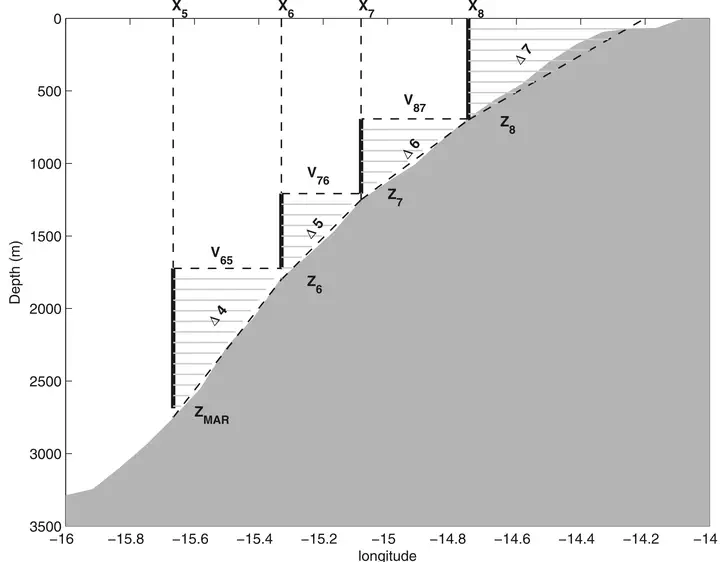The Accuracy of Estimates of the Overturning Circulation from Basin Wide Mooring Arrays
 Enlargement of the eastern boundary portion of the mooring array showing the construction of virtual mooring D4 by concatenation of component moorings. Horizontal shading indicates unsampled re- gions (each is labeled for reference). See text for explanation of other symbols.
Enlargement of the eastern boundary portion of the mooring array showing the construction of virtual mooring D4 by concatenation of component moorings. Horizontal shading indicates unsampled re- gions (each is labeled for reference). See text for explanation of other symbols.Abstract
Previous modeling and observational studies have established that it is possible to accurately monitor the Atlantic Meridional Overturning Circulation (AMOC) at 26.5°N using a coast-to-coast array of instrumented moorings supplemented by direct transport measurements in key boundary regions (the RAPID/MOCHA/WBTS Array). The main sources of observational and structural errors have been identified in a variety of individual studies. Here a unified framework for identifying and quantifying structural errors associated with the RAPID array-based AMOC estimates is established using a high-resolution (eddy resolving at low-mid latitudes, eddy permitting elsewhere) ocean general circulation model, which simulates the ocean state between 1978 and 2010. We define a virtual RAPID array in the model in close analogy to the real RAPID array and compare the AMOC estimate from the virtual array with the true model AMOC. The model analysis suggests that the RAPID method underestimates the mean AMOC by ∼1.5 Sv (1 Sv = 106 m3 s−1) at ∼900 m depth, however it captures the variability to high accuracy. We examine three major contributions to the streamfunction bias: (i) due to the assumption of a single fixed reference level for calculation of geostrophic transports, (ii) due to regions not sampled by the array and (iii) due to ageostrophic transport. A key element in (i) and (iii) is use of the model sea surface height to establish the true (or absolute) geostrophic transport. In the upper 2000 m, we find that the reference level bias is strongest and most variable in time, whereas the bias due to unsampled regions is largest below 3000 m. The ageostrophic transport is significant in the upper 1000 m but shows very little variability. The results establish, for the first time, the uncertainty of the AMOC estimate due to the combined structural errors in the measurement design and suggest ways in which the error could be reduced. Our work has appli- cations to basin-wide circulation measurement arrays at other latitudes and in other basins as well as quantifying systematic errors in ocean model estimates of the AMOC at 26.5°N.